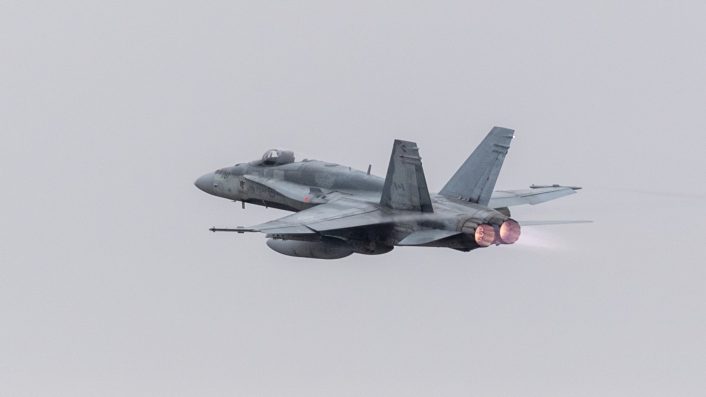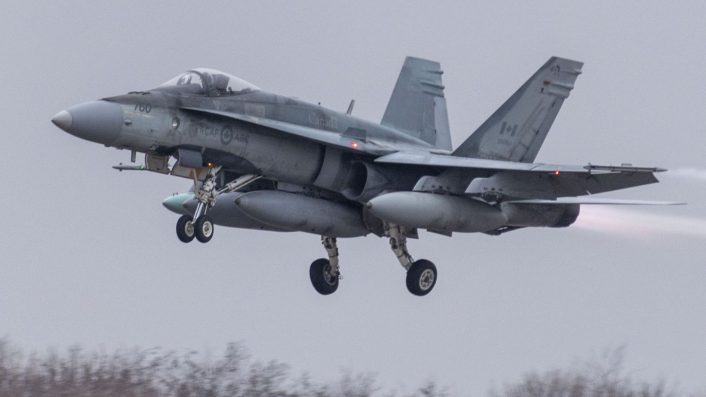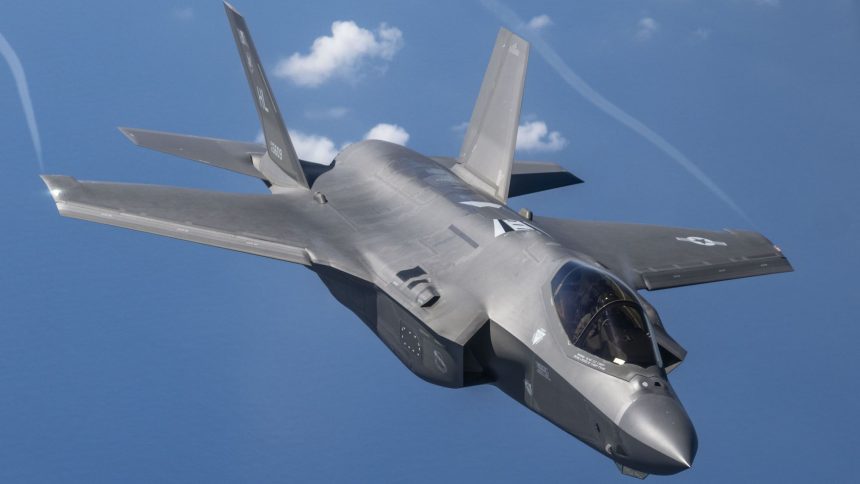Secretary of State for Defense Procurement Stephen Fuhr said Canada has no plans to exit the contract for the 16 F-35s already in production, with a decision pending on the remaining 72 jets.
Canada will get at least 16 F-35 Lightning II jets to equip the Royal Canadian Air Force (RCAF), with a decision still pending on the remaining 72 jets out of a total order of 88. The announcement follows the reports in March 2025 about Canada reconsidering its participation in the F-35 program following diplomatic tensions with the United States.
Following these reports, Canada was said to be considering leaving altogether the F-35 program and considering alternatives, with the Saab JAS-39 Gripen named one possible contender. Then defense minister Bill Blair said on Mar. 14: “Canada is actively looking at potential alternatives to the U.S.-built F-35 stealth fighter and will hold conversations with rival aircraft makers.”
However, no final decision has been made yet, and it is not expected to involve the 16 jets Canada already paid for.
Canada obligated to 16 aircraft
Canada’s Secretary of State for Defense Procurement Stephen Fuhr took part in an interview on CBC’s Rosemary Barton Live talk-show. One of the questions specifically involved the possibility of Canada exiting the contract after the first 16 F-35s.
In his reply, Fuhr said he “doesn’t think the federal government plans to get out of its contract to buy American-made F-35 fighter jets as 16 planes are currently being manufactured.” The CBC report on Oct. 5, 2025, quoted Fuhr: “I don’t think that’s the direction we’re heading. But there’ll be a decision and we’ll make it when we’re ready.”
F-35A at Abbotsford International Airshow, British Columbia, Canada (August 8, 2025). Developed from F-22’s P&W F119 engine, the F-35’s P&W F135 is considered one of the most powerful operational fighter jet engines in the world, producing over 40,000 lbs of thrust. pic.twitter.com/oWmfjtqICR
— Air Power (@RealAirPower1) August 20, 2025
Although not stated explicitly by Fuhr, a spokesperson later clarified that he was referring to the 16 jets that Canada has transferred funds for, not the entire fleet. “Canada is contractually obligated to 16 aircraft, which are in various stages of production with the manufacturer. A decision on the full program is currently under review,” said the spokesperson.
It is unclear if Canada would have exited the entire program without any F-35 jets had it not transferred funds for the first 16 aircraft. Canada is considering with great seriousness the decision and the impact of the fallout with the U.S.
Canada has so far paid in full for four aircraft, and parts for eight other jets have been purchased. The F-35s will be delivered to Luke AFB in Arizona, where the first Canadian pilots and ground crew and maintainers will undergo training next year.
Canada in F-35 program
Canada is a partner in the Joint Strike Fighter program, with approximately USD 500 million spent since 1997 and Canadian companies securing F-35-related contracts for over USD 1.8 billion. The government decided to buy 65 F-35s in 2010 without competition, however in 2015 the plan was scrapped in favor of an open competition.

The government eventually announced on Jan. 9, 2023, the intent to purchase 88 F-35s from Lockheed Martin in a deal valued, at the time, $13.2 billion This was part of the Future Fighter Capability Project (FFCP) to replace the RCAF’s fleet of legacy CF-188 Hornets (local designation of the F/A-18). The deliveries of the first 16 aircraft are expected to start by early-2026.
Canada’s then Defense Minister Bill Blair hinted in Mar. 2025, while announcing “potential alternatives” to the F-35, that the plan might change, and Ottawa might accept the first batch of F-35s while diversifying the rest of the fleet. Reports had said that Canada could look at European suppliers, with Sweden’s Saab Gripen as a major contender.
The RCAF presently operates 70-75 CF-188A/B+ jets and has also purchased 25 older 18 F/A-18A/Bs from the Royal Australian Air Force (RAAF). Of these, 12 are single seater F/A-18As, six are twin-seat ‘B’ variants, while the remaining seven are non-flyable Hornets to be cannibalized for spares and components. These are expected to continue flying until the early 2030s.
Possibly only 16 F-35s
In the Rosemary Barton show, Fuhr told the host that Prime Minister Mark Carney “will make a decision [on the contract] when he’s ready.” Right now, there is only the confirmation for the first batch, as the spokesperson for Fuhr said “Canada is contractually obligated to 16 aircraft, which are in various stages of production with the manufacturer.”
“There’s infrastructure being built out at the two main operating bases. And when [Carney] is comfortable with making a decision, he’ll make it,” further said Fuhr. He also denied any ties between the decision on the F-35 and Canada’s push to negotiate a trade deal with President Donald Trump. “No, I’m not considering that. Again, we’re a sovereign country. We’ll make our own decisions and we’ll stand on our own two feet,” he said.

The CBC also touched upon a June Auditor General of Canada (equivalent to the Government Accountability Office in the U.S) report that noted a whopping increase from the $19 billion price tag to $27.7 billion for the 88 F-35As. The AG cited “inflation and increased global demand for munitions” as two of the prime reasons, since Canada would also be expected to buy missiles like the AIM-120 AMRAAM, AIM-9X Sidewinder, besides possibly air-to-ground munitions.
Additionally, F-35A Lightning II-centric infrastructure upgrades are also required at Canada’s older bases at CFB (Canadian Forces Base) Bagotville, Quebec, and CFB Cold Lake, Alberta, to handle the jets. These works are also running behind schedule, possibly adding to the overall cost-overruns.
Mixed fleet
The possibility of acquiring a European alternative like the Saab JAS-39 Gripen had also shone the spotlight on the logistical and infrastructural difficulties of operating three different types of aircraft, given the diverse supply chains and operational and training systems. Opinions are divided among Canada’s political and military leadership.
End Ex! 🇨🇦🇬🇧
RCAF wraps up 3 intense weeks at #CobraWarrior 25-2 with @RoyalAirForce. Day & night ops with @NATO allies sharpened tactics & boosted interoperability. Canada reinforced its role in securing airspace, wherever the missions take us.#AirPower #OpREASSURANCE pic.twitter.com/1yggofpSMb
— Royal Canadian Air Force (@RCAF_ARC) October 3, 2025
Fuhr is in favor of a mixed fleet, telling CBC: “What happens if you have to persist in that space for months and months and years? The tool that you use, is it the right tool to do that job? That’s a very simplistic way of looking at it. But we need to have a whole wide range of capability sets to deal with all the eventualities that we could face.”
Outstanding work by the Canadian 🇨🇦and Continental 🇺🇸 #NORAD regions for their operational excellence during #GlobalGuardian. Bomber missions demonstrate the credibility of our forces to address a global security environment that is more diverse and uncertain than at any other… pic.twitter.com/TdzgVnyUvF
— North American Aerospace Defense Command (@NORADCommand) August 26, 2025
An Oct. 7, 2025, report by CBC quoted Deputy Defense Minister Stefani Beck telling a House of Commons committee that Canada is proceeding “full steam ahead” on the F-35 “until [they] hear otherwise.” CBC also said the new RCAF commander Lt. Gen. Jamie Spenser-Blanchet was asked about the mixed fleet of aircraft, however “She partially ducked the questions by saying the air force will be required to manage two fleets throughout the introduction of the F-35 because the current CF-18s are expected to continue flying until the early 2030s.”
Speiser-Blanchet did, however, say that operating two separate fleets would be more costly and complicated. “It would duplicate a certain amount of infrastructure and training,” she said.
From Sept 11–15, 410 Sqn deployed to CFB Comox for #FOXFRENZY25. Daily CF-18 Hornet flights supported Fighter Pilot Course and readiness training. This key event boosts prep for future CAF missions. #RCAF #CAFTraining 📸:S1 Brendan Gibson pic.twitter.com/Uyk52o67qF
— RCAF Operations (@RCAFOperations) September 17, 2025
The same report also quoted retired RCAF Maj. Gen. Duff Sullivan, who supported the idea of a mixed fleet, pointing to the U.S. Air Force’s use of F-22s and F-16s in Alaska, with Canadian CF-18s also used for continental defense. “So here we have three different types of aircraft, but what makes us inter-operable are our tactics and procedures, not the type of aircraft.”









